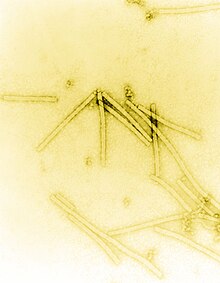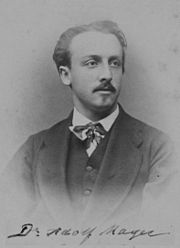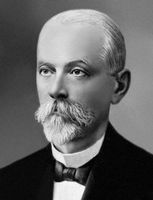History of virology

The history of virology – the scientific study of
The subsequent discovery and partial characterization of
Pioneers



Despite his other successes, Louis Pasteur (1822–1895) was unable to find a causative agent for rabies and speculated about a pathogen too small to be detected using a microscope.[1] In 1884, the French microbiologist Charles Chamberland (1851–1931) invented a filter – known today as the Chamberland filter – that had pores smaller than bacteria. Thus, he could pass a solution containing bacteria through the filter and completely remove them from the solution.[2]
In 1876,
In 1898, the Dutch microbiologist Martinus Beijerinck (1851–1931), a microbiology teacher at the Agricultural School in Wageningen repeated experiments by Adolf Mayer and became convinced that filtrate contained a new form of infectious agent.[4] He observed that the agent multiplied only in cells that were dividing and he called it a contagium vivum fluidum (soluble living germ) and re-introduced the word virus.[3] Beijerinck maintained that viruses were liquid in nature, a theory later discredited by the American biochemist and virologist Wendell Meredith Stanley (1904–1971), who proved that they were in fact, particles.[3] In the same year, 1898, Friedrich Loeffler (1852–1915) and Paul Frosch (1860–1928) passed the first animal virus through a similar filter and discovered the cause of foot-and-mouth disease.[5]
The first human virus to be identified was the
By 1928 enough was known about viruses to enable the publication of Filterable Viruses, a collection of essays covering all known viruses edited by Thomas Milton Rivers (1888–1962). Rivers, a survivor of typhoid fever contracted at the age of twelve, went on to have a distinguished career in virology. In 1926, he was invited to speak at a meeting organised by the Society of American Bacteriology where he said for the first time, "Viruses appear to be obligate parasites in the sense that their reproduction is dependent on living cells."[11]
The notion that viruses were particles was not considered unnatural and fitted in nicely with the
In 1935, Wendell Stanley examined the tobacco mosaic virus and found it was mostly made of protein.
In Pasteur's day, and for many years after his death, the word "virus" was used to describe any cause of infectious disease. Many bacteriologists soon discovered the cause of numerous infections. However, some infections remained, many of them horrendous, for which no bacterial cause could be found. These agents were invisible and could only be grown in living animals. The discovery of viruses paved the way to understanding these mysterious infections. And, although Koch's postulates could not be fulfilled for many of these infections, this did not stop the pioneer virologists from looking for viruses in infections for which no other cause could be found.[19]
Bacteriophages

Discovery
1920–1940: Early research
D'Herelle travelled widely to promote the use of bacteriophages in the treatment of bacterial infections. In 1928, he became professor of biology at
Modern era
Knowledge of bacteriophages increased in the 1940s following the formation of the Phage Group by scientists throughout the US. Among the members were Max Delbrück (1906–1981) who founded a course on bacteriophages at Cold Spring Harbor Laboratory.[26] Other key members of the Phage Group included Salvador Luria (1912–1991) and Alfred Hershey (1908–1997). During the 1950s, Hershey and Chase made important discoveries on the replication of DNA during their studies on a bacteriophage called T2. Together with Delbruck they were jointly awarded the 1969 Nobel Prize in Physiology or Medicine "for their discoveries concerning the replication mechanism and the genetic structure of viruses".[31] Since then, the study of bacteriophages has provided insights into the switching on and off of genes, and a useful mechanism for introducing foreign genes into bacteria and many other fundamental mechanisms of molecular biology.[32]
Plant viruses
In 1882, Adolf Mayer (1843–1942) described a condition of tobacco plants, which he called "mosaic disease" ("mozaïkziekte"). The diseased plants had variegated leaves that were mottled.[33] He excluded the possibility of a fungal infection and could not detect any bacterium and speculated that a "soluble, enzyme-like infectious principle was involved".[34] He did not pursue his idea any further, and it was the filtration experiments of Ivanovsky and Beijerinck that suggested the cause was a previously unrecognised infectious agent. After tobacco mosaic was recognized as a virus disease, virus infections of many other plants were discovered.[34]
The importance of tobacco mosaic virus in the history of viruses cannot be overstated. It was the first virus to be discovered, and the first to be
By 1935, many plant diseases were thought to be caused by viruses. In 1922,
In 1970, the Russian plant virologist Joseph Atabekov discovered that many plant viruses only infect a single species of host plant.[37] The International Committee on Taxonomy of Viruses now recognises over 900 plant viruses.[40]
20th century
By the end of the 19th century, viruses were defined in terms of their infectivity, their ability to be filtered, and their requirement for living hosts. Up until this time, viruses had only been grown in plants and animals, but in 1906, Ross Granville Harrison (1870–1959) invented a method for growing tissue in lymph,[41] and, in 1913, E Steinhardt, C Israeli, and RA Lambert used this method to grow vaccinia virus in fragments of guinea pig corneal tissue.[42] In 1928, HB and MC Maitland grew vaccinia virus in suspensions of minced hens' kidneys.[43] Their method was not widely adopted until the 1950s, when poliovirus was grown on a large scale for vaccine production.[44] In 1941–42, George Hirst (1909–94) developed assays based on haemagglutination to quantify a wide range of viruses as well as virus-specific antibodies in serum.[45][46]
Influenza

Although the
Poliomyelitis
In 1949,
Epstein–Barr virus
Late 20th and early 21st century

The second half of the 20th century was the golden age of virus discovery and most of the 2,000 recognised species of animal, plant, and bacterial viruses were discovered during these years. New viruses and strains of viruses were discovered in every decade of the second half of the 20th century. These discoveries have continued in the 21st century as new viral diseases such as
| Year | Virus | References |
|---|---|---|
| 1908 | poliovirus | [75] |
| 1911 | Rous sarcoma virus | [76] |
| 1915 | bacteriophage of staphylococci | [20] |
| 1917 | bacteriophage of shigellae | [20] |
| 1918 | bacteriophage of salmonellae | [22] |
| 1927 | yellow fever virus | [77] |
| 1930 | western equine encephalitis virus | [78] |
| 1933 | eastern equine encephalitis virus
|
[78] |
| 1934 | mumps virus | [79] |
| 1935 | Japanese encephalitis virus | [80] |
| 1943 | Dengue virus
|
[81] |
| 1949 | enteroviruses | [82] |
| 1952 | Varicella zoster virus | [63] |
| 1953 | adenovirus
|
[83] |
| 1954 | measles virus
|
[65] |
| 1956 | paramyxoviruses, rhinovirus | [64][66] |
| 1958 | monkeypox
|
[84] |
| 1962 | rubella virus | [85] |
| 1963 | hepatitis B virus | [86] |
| 1964 | Epstein–Barr virus | [87] |
| 1965 | retroviruses | [88] |
| 1966 | Lassa fever virus | [89] |
| 1967 | Marburg virus | [90] |
| 1972 | norovirus | [91] |
| 1973 | hepatitis A virus
|
[92][93] |
| 1975 | parvovirus B19 | [94] |
| 1976 | Ebola virus | [95] |
| 1980 | human T-lymphotropic virus 1 | [96] |
| 1982 | human T-lymphotropic virus 2 | [96] |
| 1983 | HIV | [97] |
| 1986 | human herpesvirus 6 | [98] |
| 1989 | hepatitis C virus | [99] |
| 1990 | Human herpesvirus 7
|
[100] |
| 1993 | hantavirus | [101] |
| 1994 | henipavirus | [102] |
| 1997 | Anelloviridae | [103] |
See also
- List of viruses
References
- PMID 12758285.
- ^ Shors 2008, pp. 76–77
- ^ a b c Topley & Wilson 1998, p. 3
- ISBN 978-1-4051-3645-7.
- ISBN 978-0-12-375146-1.
- PMID 18728272.
- PMID 2684378.
- PMID 11482006.
- PMID 2673502.
- PMID 20589188.
- PMID 11615452.
- ^ *In 1887, Buist visualised one of the largest, Vaccinia virus, by optical microscopy after staining it. Vaccinia was not known to be a virus at that time. Buist J (1887). Vaccinia and Variola: a study of their life history. London: Churchill.
- ISBN 978-9810207281.
- OCLC 499302635.
- PMID 17756690.
- PMID 17788438.
- .
- ISBN 978-0-7637-5963-6.
- ^ The Microbe 1984, p. 3
- ^ ISBN 978-0-7637-2932-5.
- ^ ISBN 9780123751621.
- ^ PMID 17855060.
- ^ ISBN 9780123751621.
- ^ "The antagonistic microbe can never be cultivated in media in the absence of the dysentery bacillus. It does not attack heat-killed dysentery bacilli, but is cultivated perfectly in a suspension of washed cells in physiological saline. This indicates that the anti dysentery microbe is an obligate bacteriophage". Felix d'Herelle (1917) An invisible microbe that is antagonistic to the dysentery bacillus (1917) Comptes rendus Acad. Sci. Paris Retrieved on 2 December 2010
- ISBN 9780123751621.
- ^ a b Shors 2008, p. 591
- ^ Shors 2008, p. 590
- ISBN 9780123751621.
- ISBN 9780123751621.
- ISBN 9780123751621.
- ^ Nobel Organisation
- ISBN 9780123751621.
- ^ Mayer A (1882) Over de moza¨ıkziekte van de tabak: voorloopige mededeeling. Tijdschr Landbouwkunde Groningen 2: 359–364 (In German)
- ^ S2CID 12180571.
- S2CID 25741967.
- ISBN 978-1-4051-3645-7.
- ^ PMID 11718380.
- ^ Shors 2008, p. 563
- JSTOR 3625805.
- ^ Shors 2008, p. 564
- ^ Nicholas J (1961). Ross Granville Harrison 1870—1959 A Biographical Memoir (PDF). National Academy of Sciences.
- .
- PMID 13475780.
- ISBN 978-0-340-66316-5.
- PMID 10196240.
- .
- ^ Shors 2008, pp. 238–344
- ISBN 978-0-19-532731-1.
- PMID 15081510.
- ^ Oldstone 2009, p. 315
- PMID 17810781.
- PMID 1104014.
- PMID 15470207.
- S2CID 32921007.
- ISBN 978-1-904455-03-5.
- PMID 19165855.
- PMID 16083776.
- S2CID 10595263.
- ^ "Discoverers and Discoveries - ICTV Files and Discussions". 11 November 2009. Archived from the original on 11 November 2009. Retrieved 5 November 2017.
- PMID 20995890.
- PMID 20197026.
- PMID 13397177.
- ^ S2CID 37547957.
- ^ PMID 15522442.
- ^ PMID 19203111.
- ^ PMID 3039038.
- S2CID 205858963.
- PMID 4348509.
- PMID 20018391.
- PMID 6189183.
- PMID 19781804.
- PMID 21116811.
- PMID 11334748.
- ISBN 978-0-12-375147-8.
- S2CID 9113713.
- S2CID 23924897.
- PMID 20513550.
- ^ PMID 19775836.
- PMID 19870227.
- S2CID 7517544.
- PMID 20513545.
- PMID 8024744.
- ISBN 978-0-7817-6060-7.
- PMID 1331540.
- PMID 3890105.
- PMID 16190102.
- PMID 4288580.
- S2CID 11865468.
- PMID 16802617.
- PMID 20513546.
- PMID 10804141.
- )
- PMID 6307916.
- S2CID 13336358.
- PMID 21084112.
- ^ PMID 16155599.
- PMID 20152474.
- PMID 15653828.
- PMID 2523562.
- PMID 20335188.
- ^ Harding A, Lanese N, Harvey A (14 December 2021). "The deadliest viruses in history". Live Science. Retrieved 23 February 2022.
- PMID 18511217.
- PMID 19230554.

